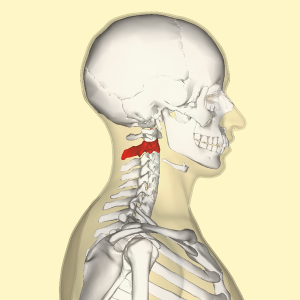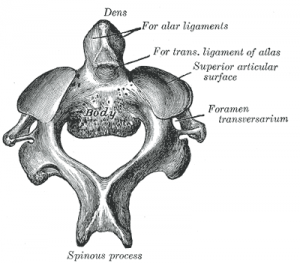Axis: Difference between revisions
mNo edit summary |
No edit summary |
||
| Line 34: | Line 34: | ||
The '''spinous process''' is large, very strong, deeply channelled on its under surface, and bifid. | The '''spinous process''' is large, very strong, deeply channelled on its under surface, and bifid. | ||
== References == | == References == | ||
| Line 44: | Line 40: | ||
<references /> | <references /> | ||
[[Category:Cervical_Anatomy]] | [[Category:Cervical_Anatomy]] [[Category:Bones]] | ||
Revision as of 01:11, 12 March 2018
Original Editor - Rachael Lowe
Top Contributors - Mandeepa Kumawat, Admin, Kim Jackson, George Prudden and WikiSysop
Introduction[edit | edit source]
The Axis forms the pivot upon which the first cervical vertebra (the Atlas), which carries the head, rotates.
Structure[edit | edit source]
Odontoid process[edit | edit source]
The most distinctive characteristic of this bone is the strong Odontoid Process (also known as the "dens") which rises perpendicularly from the upper surface of the body. Posteriorly the Odontoid process is flattened where it articulates with the transverse ligament.
Vertebral body[edit | edit source]
The body is deeper in front than behind, and prolonged downward anteriorly so as to overlap the upper and front part of the third vertebra. It presents in front a median longitudinal ridge, separating two lateral depressions for the attachment of the Longus colli muscles. Its under surface is concave from before backward and convex from side to side.
Other Structures[edit | edit source]
The pedicles are broad and strong, especially in front, where they coalesce with the sides of the body and the root of the odontoid process. They are covered above by the superior articular surfaces.
The laminae are thick and strong, and the vertebral foramen large, but smaller than that of the atlas.
The transverse processes are very small, and each ends in a single tubercle; each is perforated by the transverse foramen, which is directed obliquely upward and laterally.
The superior articular surfaces are round, slightly convex, directed upward and laterally, and are supported on the body, pedicles, and transverse processes.
The inferior articular surfaces have the same direction as those of the other cervical vertebrae.
The superior vertebral notches are very shallow, and lie behind the articular processes; the inferior lie in front of the articular processes, as in the other cervical vertebrae.
The spinous process is large, very strong, deeply channelled on its under surface, and bifid.
References[edit | edit source]
References will automatically be added here, see adding references tutorial.








